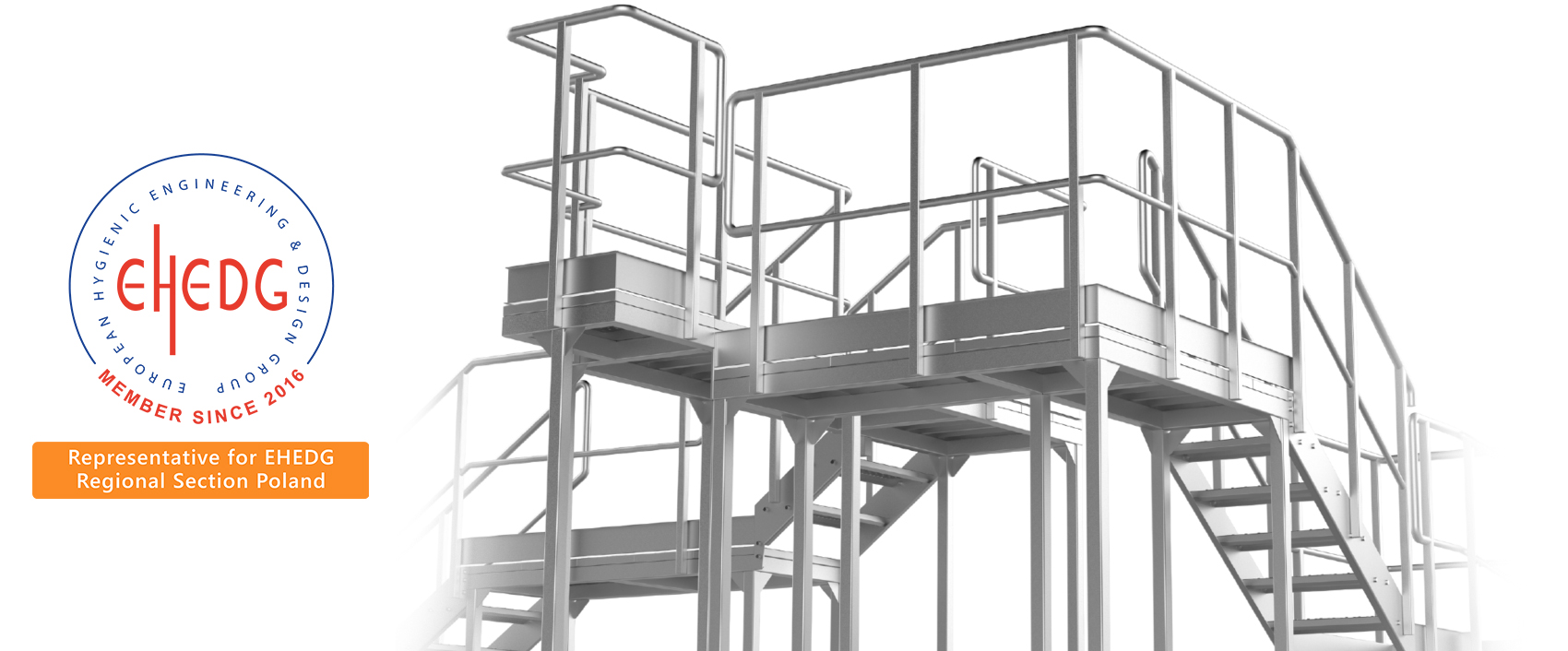
Author: Krzysztof Kaczmarczyk, Technology Manager
ATT became the member of EHEDG in 2016. Since 2022 the entity has been the Representative of EHEDG Regional Section Poland. ATT is specialized in design, manufacturing, and installation of food processing facilities equipment globally. The product portfolio includes drainage systems, platforms, kerbs, bollards, manhole covers. ATT competences covers also dedicated construction elements designed and manufactured exclusively for its customers.
Stainless steel platforms and structures in food & beverage processing plants
Production infrastructure often requires work to be carried out at heights. These processes are classified as highly hazardous and should therefore be performed with the highest safety standards. Platforms and process walkways are part of that manufacturing environment. Due to production lines equipped with the above-mentioned engineering structures, an employee can work in stable manner.
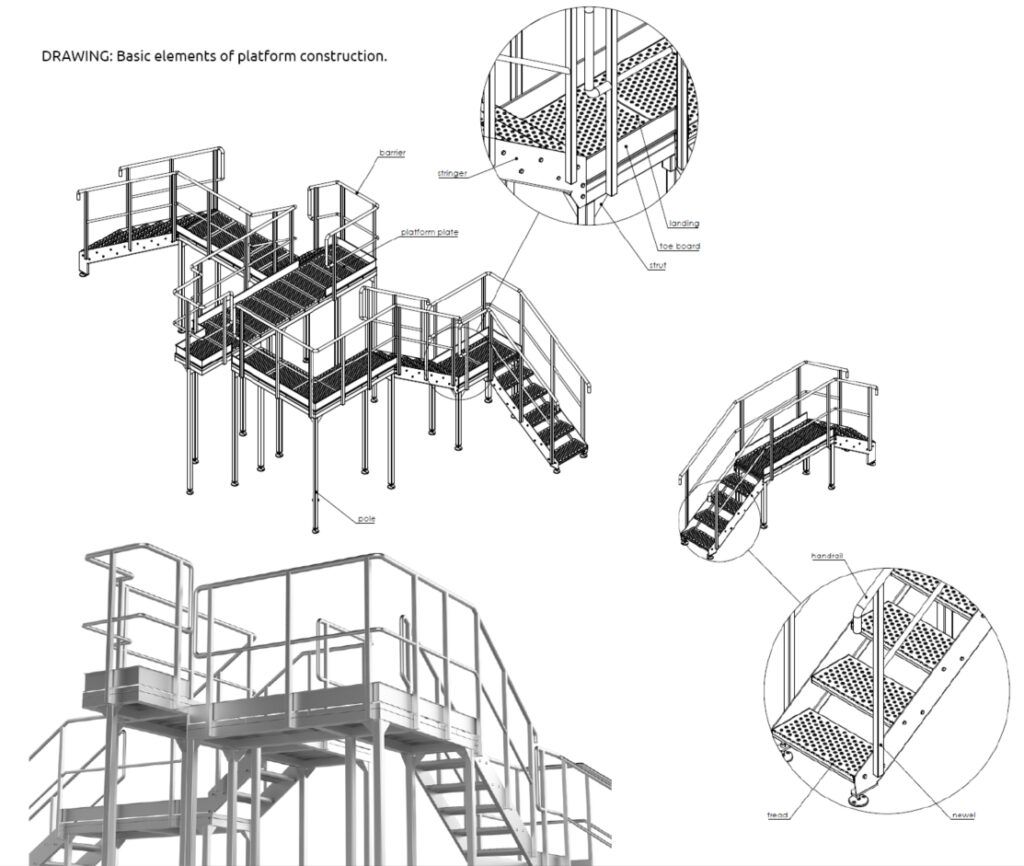
Key norms and guidelines related to platforms design and construction
Platform structures shall be designed and manufactured in accordance with the applicable standards listed below.
1. Machinery – Safety – Permanent means of access to machinery
Part 1: Selection of permanent means of access between two levels – EN ISO 14122-1:2016-08
2. Safety of machinery – Permanent means of access to machinery
Part 2: Working platforms and walkways – EN ISO 14122-2:2016-08
3. Safety of machinery – Permanent means of access to machinery
Part 3: Stairs, ladder-stairs, and railings – EN ISO 14122-3:2016-08
4. Safety of machinery – Permanent means of access to machinery
Part 4: Fixed ladders – EN ISO 14122-4:2016-08
5. EN 1090-1:2012 Part 1: Principles for conformity assessment of structural components*
6. EN 1090-2:2012 Part 2: Technical requirements for steel structures*
7. EN 1090-3 2012 Part 3: Technical requirements for aluminium structures*
*Regulation 305/2011 of the European Parliament and of the Council (CPR) obliges manufacturers of steel structures to issue a Declaration of Performance and to mark the product with the CE mark, thus, to implement a Factory Production Control system according to EN 1090 in their organisations.
Smart increase of efficiency – finite element analysis – advantages
A very important element of any engineering structure (for example platforms or technical walkways) is a static calculation, which assures the end user of the load-bearing capacity of the construction. Each structure supplied to the F&B should be accompanied by a static design documentation. Ideally, the static calculation is to be carried out already at the basic design stage. However, the task is time-consuming and creates a burden on the client’s wallet.
Estimates also brings the risk of under or overestimating of structural assumptions. Finite Element Analysis – due to very accurate algorithms applied is a great support to structural design and construction engineers. Using the method at the very early stage of design process, we can analyse the mechanical features of a structure and optimise the product in terms of engineering requirements. Savings of up to 30 % in relation to the original input data can be achieved by optimising designs with the help of FEA.
Hygienic aspects of platforms and steel structures
Hygienic design is the highest priority for all constructions supplied to F&B processing plants. The EHEDG guidelines specify features to be taken into consideration to ensure that the design of the platform is as hygienic as possible.
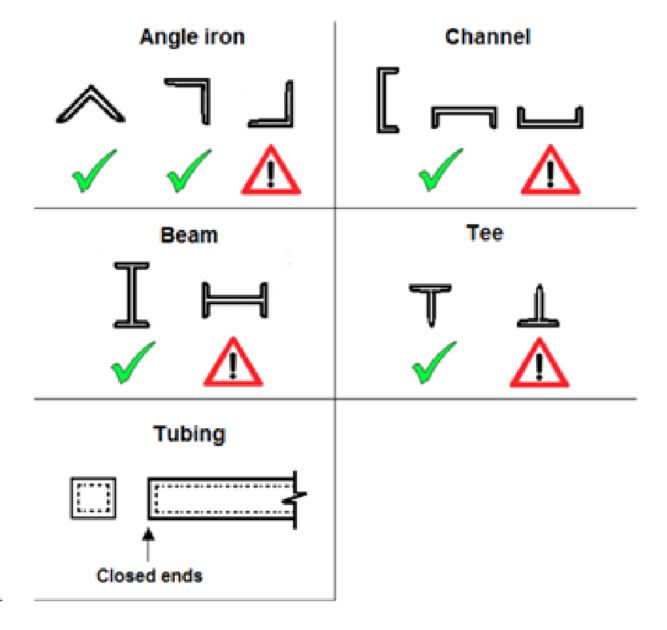
The fundamental factor affecting quality of hygiene in production zones in F&B sector is the material that must be chemically inert (does not penetrate food) and resistant to chemicals used in cleaning processes in F&B production zones. The material meeting these requirements is stainless steel grade: 1.4301 or 1.4404 Key challenge for a construction producer is to meet customer functional expectations while keeping highest hygienic requirements. Part of food manufacturers prefer to use solutions based on open profiles (angles, channels, T-sections), while the other part promotes closed profiles (square and round tubes) The following graphic shows the hygienically correct positions of profiles in a platform design (source EHEDG_DOC_44_E_2014).
Welding is one of the most importan and the most vulnerable procution process of platforms. The design technology in accordance with hygienic guidelines should avoid, if possible, location of welds in any spots where dirt can accumulate thus bacteria are multiplied, for example corner welds. Another crutitial element in hygienic welded elements is the quality of welds finish. The best results are achieved with the 141 (TiG) method, which guarantees welds of a high purity class. TIG welding preformance avoid creation of weld slag. Slag mixed with the weld material makes the welding joint weeaker and less resistant to external factors.
It is essential for hygiene quality that all welds are pickled. The corrosion resistance of stainless steel depends on the ability to form a thin, very durable chromium-rich oxide layer on its surface. Such a layer can be damaged during processes associated with manufacturing of stainless-steel elements. The main reason for the breakage of the passive layer is an exposure to high temperatures during material processing (bending, punching) and welding. Etching is a chemical process that removes the top layer of a material along with harmful oxides and iron inclusions. It uses strong oxidizing acids such as nitric acid or hydrofluoric acid. The process is carried out with the help of pickling baths or with the help of pastes and gels. Bath pickling method provides highly effective removal of the negative production effects and welding procedures due to the fact it is carried out with very high precision and efficiency. A very beneficial process that should be carried out after the pickling process is passivation. The procedure also removes impurities and, more importantly, strengthens the passivation layer on the steel surface. It is carried out in the same way as the pickling – by immersion or by spraying with a passivator.
Another widely used welding technology is the method 135 (MIG/MAG). This method is faster, but the quality of welds is significantly lower and it should not be applied to structures installed directly in F&B processing environment. If the technical conditions do not allow the use of the TiG method, the MAG welds should be properly processed to improve its hygienic properties for example by grinding procedure.
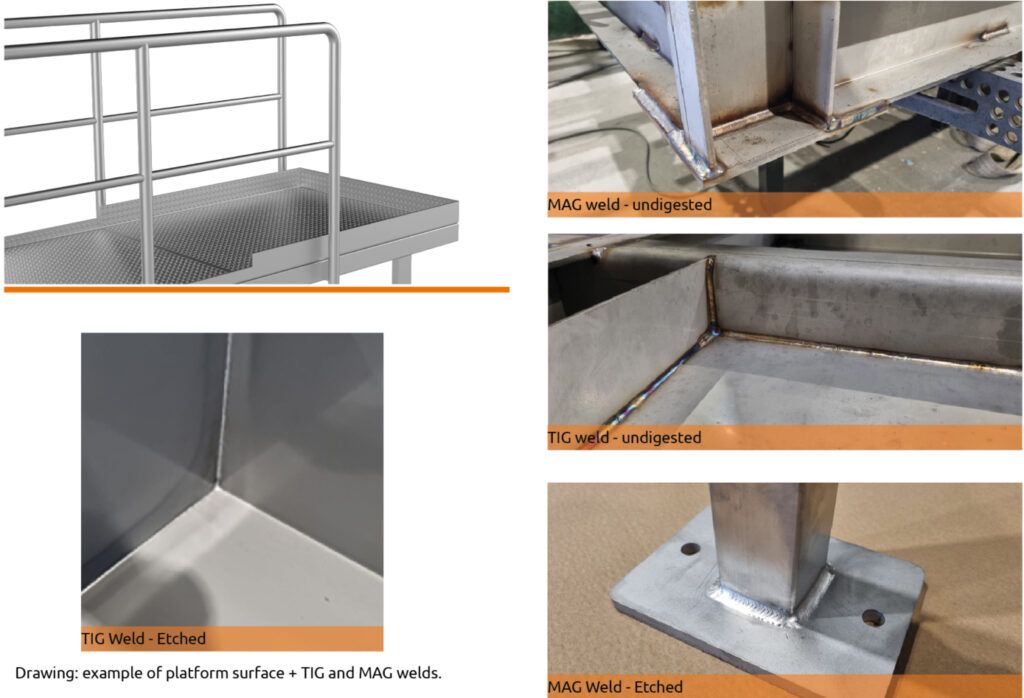
Walking surface is another hygienicaly important aspect of the platform constuction. The most offten used solutions are listed below sorted from the highest to the lowest hygienic value:
– checker plate – easy to clean, good anti-slip features;
– upturned steel perforation (USP) platform – easy to clean, very good anti-slip features;
– mash-grating – poor hygienic quality,
very good anti-slip features.
The checker plate and the USP type of platforms are cosidered as hygienic application in food production areas. We find USP design as the most optimal solution with optimal combination of hygienic and safety requirements. Mash grating platforms are the least hygienic and should be avoided in F&B production zones.
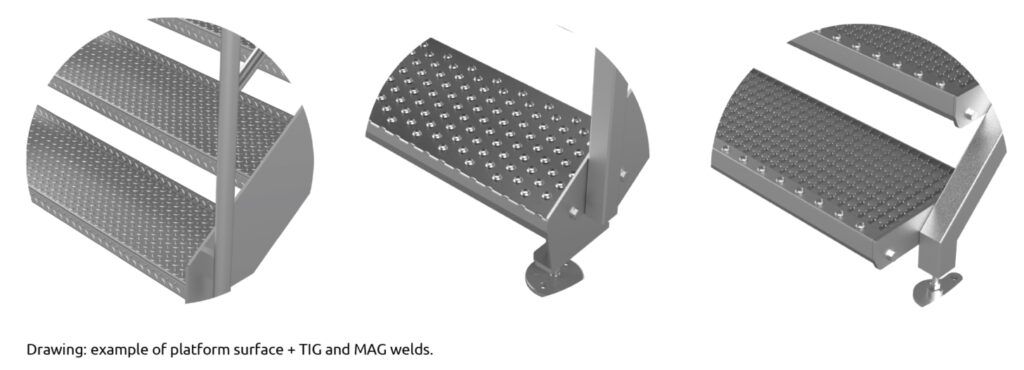
Protective railings are highly important safety providing element in working areas of the construction. Round tubes are considered as most hygienic choice. The welding joints on the handrails should be grinded to guarantee safe usage. The end of the handrail lines should be blinded or made as a bent element.
Below there are illustrations of hygienically unappropriated design of railings.

Summary
Nowadays, producers of platforms and construction elements are facing three fundamental trends:
• efficiency of the structure (rising production costs)
• safety of operators
• highest hygiene level dedicated to F&B sector
Unstable and rapidly growing prices of materials, utilities (electricity, gas) generate cost cutting pressure on manufactures and eventually unpredictable price hikes of products for end users. Algorithms used in Finite Element Analysis methodology support producers with cost optimization processes providing that safety of steel structures is not jeopardized.
The global social experience of COVID-19 pandemic has raised customer’s awareness of the importance of hygiene at every area of life. Platforms, technical walkways steel structures, as the key infrastructure in F&B production halls must meet the highest hygienic design standards, as mentioned in the above article as well as in EHEDG_DOC_44_E_2014 guidelines.
At the end, all measures raising safety and hygiene of F&B production processes bring invaluable benefits to producers. Through smart optimisation – production costs are reduced and manufacturing safety is improved. On the other hand, by introducing hygienic design, cleaning and maintenance costs of factories are significantly reduced as well as production security is upgraded.

 Następny
Następny
